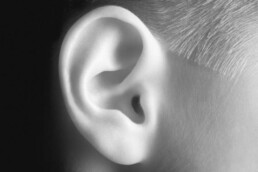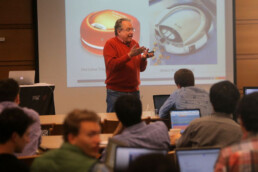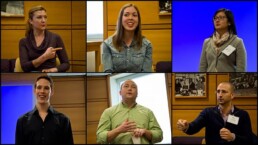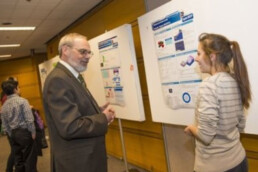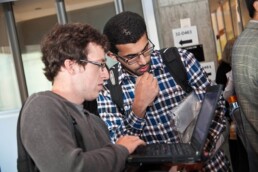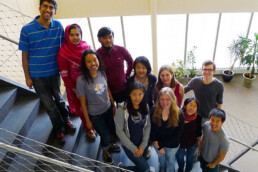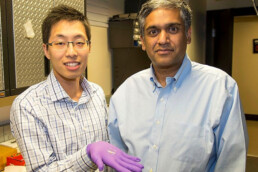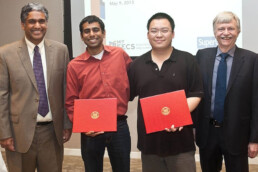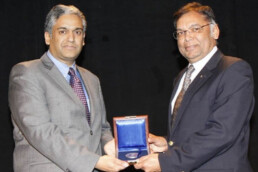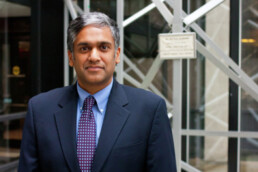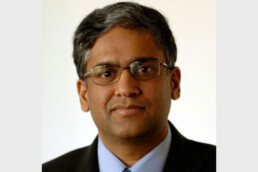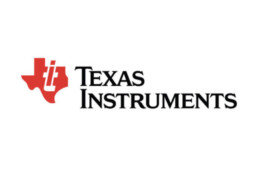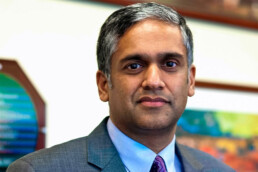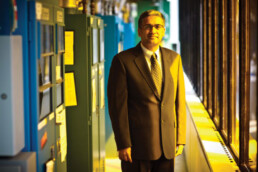Cochlear implants — with no exterior hardware
A cochlear implant that can be wirelessly recharged would use the natural microphone of the middle ear rather than a skull-mounted sensor.
Cochlear implants — medical devices that electrically stimulate the auditory nerve — have granted at least limited hearing to hundreds of thousands of people worldwide who otherwise would be totally deaf. Existing versions of the device, however, require that a disk-shaped transmitter about an inch in diameter be affixed to the skull, with a wire snaking down to a joint microphone and power source that looks like an oversized hearing aid around the patient’s ear.
Researchers at MIT’s Microsystems Technology Laboratory (MTL), together with physicians from Harvard Medical School and the Massachusetts Eye and Ear Infirmary (MEEI), have developed a new, low-power signal-processing chip that could lead to a cochlear implant that requires no external hardware. The implant would be wirelessly recharged and would run for about eight hours on each charge.
MIT retools to aid students with startups
Is it possible MIT is feeling inadequate — insecure even?
That seems hard to imagine for the school that helped invent the transistor radio, radar, Technicolor, modern robotics, and essentially the field of biotechnology, and whose famous graduates include a Treasury secretary, Israeli prime minister, an astronaut who walked on the moon, and dozens of Nobel Prize winners.
But the Massachusetts Institute of Technology is facing increasing competition from around the corner and across the country.
Its neighbor, Harvard University, is building an innovation campus and business park in Allston to rival MIT’s backyard in Kendall Square. And in Silicon Valley, Stanford University has emerged as the center of gravity for this exciting new era, in which seemingly every other bright young student is starting a new company, and more than a few of them are becoming overnight millionaires.
Start6 inspires student engineers to become entrepreneurs
In Start6, a new entrepreneurship program for MIT engineering students offered during IAP, participants have received advice from such guest speakers as Paul English, cofounder of Kayak; Mike Evans ’99, MEng ’00, and COO and cofounder of GrubHub; Marina Hatsopoulos ’92, serial entrepreneur, former CEO and director of Z Corporation, and angel investor; and Max Krohn ’08, cofounder of OkCupid. And that was just on the first day.
The three-week workshop, which began Jan. 13, also features visits from Drew Houston ’05, CEO and cofounder of Dropbox; Google vice president Jeremy Wertheimer ’89, former CEO of ITA Software; Nanxi Liu, a 23-year-old who has already founded two successful startups; Rodney Brooks, founder, chairman, and CTO of Rethink Robotics and Panasonic Professor of Robotics (emeritus) at MIT; Ray Stata ’57, cofounder of Analog Devices; and Robert Langer, prolific inventor and entrepreneur and the David H. Koch Institute Professor at MIT. In addition, venture capitalists Peter Levine of Andreessen Horowitz and Jamie Goldstein ’89 of North Bridge Venture Partners walked the Start6 students through the various phases of a startup.
Industry finds ‘top-notch engineering students’ in SuperUROP
On Dec. 5, Paul Bassett ’85 traveled to Cambridge from Austin, Tex., where he works as a senior director of technology for the wireless communications giant Qualcomm. He wound his way through a crowd assembled in the Grier Room at MIT, where nearly 80 undergraduates in electrical engineering and computer science (EECS) presented posters on cutting-edge research projects. Qualcomm sponsors several of those students as part of the MIT SuperUROP program.
Under the leadership of EECS department head Anantha P. Chandrakasan, the Joseph F. and Nancy P. Keithley Professor of Electrical Engineering, and MIT’s Undergraduate Research Opportunities Program, SuperUROP launched last year as a way to offer undergraduates a deep dive into research.
SuperUROP raises bar for undergraduate research and innovation
EECS September kickoff reception features guest speakers Susan Hockfield and Ray Stata
The MIT Department of Electrical Engineering and Computer Science (EECS) held a kickoff reception at the Stata Center on Sept. 26 for 80 of its juniors and seniors who recently started their yearlong participation in the Advanced Undergraduate Research Opportunities Program (or SuperUROP).
Speakers at the reception praised SuperUROP, now in its second year, for continuing to raise the bar at MIT for undergraduate research and innovation, while fostering collaboration between faculty and industry.
MIT’s EECS department embraces student leadership
When Anantha Chandrakasan, the Joseph F. and Nancy P. Keithley Professor of Electrical Engineering, took the helm of MIT’s Department of Electrical Engineering and Computer Science (EECS) in 2011, he quickly set two big ideas into motion. One was to make the Undergraduate Research Opportunities Program (UROP) more appealing to EECS majors. The goal was to offer Course 6 undergraduates more research options within the department, as well as chances to work on longer-term, sustained projects.
The other was to form the Undergraduate Student Advisory Group in EECS (USAGE) to help him understand the student perspective. This group provided pivotal feedback that helped guide decisions about UROPs. Giving the students a stronger voice has transformed the department into more than a place where students come to learn about devices, signals, theory and systems: Course 6 is also a place where students become leaders.
Detecting early-stage malarial infection
New prototype device recognizes electrical properties of infected cells as signatures of disease.
Researchers at MIT have found a way to detect early-stage malarial infection of blood cells by measuring changes in the infected cells’ electrical properties.
The scientists, from the laboratories of MIT’s Anantha Chandrakasan and Subra Suresh — who is now president of Carnegie Mellon University — have built an experimental microfluidic device that takes a drop of blood and streams it across an electrode that measures a signal differentiating infected cells from uninfected cells. The work, published Aug. 8 in the journal Lab on a Chip, is a first step toward a field-ready, low-cost, portable malaria-detection device.
First ‘SuperUROPs’ cap off inaugural year
EECS program immerses undergraduates in advanced research projects.
How can crowdsourcing help plan your next vacation? How good are government officials at living up to their promises? And who among the millions of students taking online courses are likeliest to drop out?
These are all questions researchers are tackling in MIT’s Department of Electrical Engineering and Computer Science (EECS). But the researchers heading up these projects aren’t faculty members or graduate students — they’re undergraduates who are making discoveries in fields like web security, bioinformatics and motion planning while balancing problem sets, campus activities and, for many seniors, job interviews.
MIT researchers build Quad HD TV chip
It took only a few years for high-definition televisions to make the transition from high-priced novelty to ubiquitous commodity — and they now seem to be heading for obsolescence just as quickly. At the Consumer Electronics Show (CES) in January, several manufacturers debuted new ultrahigh-definition, or UHD, models (also known as 4K or Quad HD) with four times the resolution of today’s HD TVs.
In addition to screens with four times the pixels, however, UHD also requires a new video-coding standard, known as high-efficiency video coding, or HEVC. Also at CES, Broadcom announced the first commercial HEVC chip, which it said will go into volume production in mid-2014.
Chandrakasan honored at ISSCC’s 60th Plenary Session
Anantha P. Chandrakasan earns prestigious award for outstanding contributions to his field.
Anantha P. Chandrakasan, the Joseph F. and Nancy P. Keithley Professor of Electrical Engineering at MIT, was honored with a prestigious award at the 60th annual IEEE International Solid-State Circuits Conference (ISSCC), held in San Francisco from Feb. 17-21.
In presenting Chandrakasan with the 2013 IEEE Donald O. Pederson Award in Solid-State Circuits, the IEEE recognized Chandrakasan for his outstanding contributions to the field of semiconductor circuits in terms of benefitting society, enhancing technology and demonstrating professional leadership. Chandrakasan, who also heads up MIT’s Department of Electrical Engineering and Computer Science, has been conference chair of ISSCC since 2010.
Picture-perfect
Quick, efficient chip cleans up common flaws in amateur photographs.
Your smartphone snapshots could be instantly converted into professional-looking photographs with just the touch of a button, thanks to a processor chip developed at MIT.
The chip, built by a team at MIT’s Microsystems Technology Laboratory, can perform tasks such as creating more realistic or enhanced lighting in a shot without destroying the scene’s ambience, in just a fraction of a second. The technology could be integrated with any smartphone, tablet computer or digital camera.
Existing computational photography systems tend to be software applications that are installed onto cameras and smartphones. However, such systems consume substantial power, take a considerable amount of time to run, and require a fair amount of knowledge on the part of the user, says the paper’s lead author, Rahul Rithe, a graduate student in MIT’s Department of Electrical Engineering and Computer Science.
Medical devices powered by the ear itself
For the first time, researchers power an implantable electronic device using an electrical potential — a natural battery — deep in the inner ear.
Deep in the inner ear of mammals is a natural battery — a chamber filled with ions that produces an electrical potential to drive neural signals. In today’s issue of the journal Nature Biotechnology, a team of researchers from MIT, the Massachusetts Eye and Ear Infirmary (MEEI) and the Harvard-MIT Division of Health Sciences and Technology (HST) demonstrate for the first time that this battery could power implantable electronic devices without impairing hearing.
The devices could monitor biological activity in the ears of people with hearing or balance impairments, or responses to therapies. Eventually, they might even deliver therapies themselves.
Chandrakasan selected for 2013 IEEE Pederson Award in Solid-State Circuits
Anantha P. Chandrakasan — the Joseph F. and Nancy P. Keithley Professor of Electrical Engineering at MIT and head of the Department of Electrical Engineering and Computer Science (EECS) — is the 2013 recipient of the IEEE Donald O. Pederson Award in Solid-State Circuits. He was cited in the award for "pioneering techniques in low-power digital and analog CMOS design."
The Solid-State Circuits Award, inaugurated in 1987, is the most prestigious IEEE award in the field of semiconductor circuits. The award was renamed in 2005 to honor Professor Donald O. Pederson, who was instrumental in establishing the IEEE Solid-State Circuits Society and the IEEE Journal of Solid-State Circuits (JSSC), considered the leading journal in the integrated circuit design field. The award is given for outstanding contributions to solid-state circuits, as exemplified by benefit to society, enhancement to technology and professional leadership.
New chip captures power from multiple sources
System developed at MIT could combine power harvested from light, heat and vibrations to run monitoring systems.
Researchers at MIT have taken a significant step toward battery-free monitoring systems — which could ultimately be used in biomedical devices, environmental sensors in remote locations and gauges in hard-to-reach spots, among other applications.
Previous work from the lab of MIT professor Anantha Chandrakasan has focused on the development of computer and wireless-communication chips that can operate at extremely low power levels, and on a variety of devices that can harness power from natural light, heat and vibrations in the environment. The latest development, carried out with doctoral student Saurav Bandyopadhyay, is a chip that could harness all three of these ambient power sources at once, optimizing power delivery.
In Your Community: Meet Anantha Chandrakasan
From Berkeley researcher to EECS department head
They told him that it wouldn’t work. “When we went to conferences, they did not believe that complex digital circuits could reliably operate at low voltages.”
Then a graduate student at the University of California, Berkeley, Professor Anantha P. Chandrakasan wasn’t entirely sure it would work either.
In the end, though, his low-power chip designs did work, and one year later, Chandrakasan gave one of the most influential talks in the history of the International Solid-State Circuits Conference. So many people attended that some couldn’t even get close enough to hear, so the organizers asked him to give the talk a second time — a first for the conference.
Batteryless energy harvester
Running electronics on body heat
MIT researchers have demonstrated a wearable power generator that uses the difference in temperature between your skin and the surrounding air – even just a couple of degrees – to produce a small, steady flow of power to run your medical monitor or your Bluetooth® headset. No need for a battery.
In the wearable power generator, a commercially available “thermal harvester” turns the temperature difference into electricity, but the generated voltage and current are tiny. The MIT solution: a novel “interface circuit” that boosts that tiny voltage to a useful level, keeps it constant despite temperature changes, and delivers the highest-ever fraction of the power from the harvester to the device.
Chandrakasan named head of electrical engineering and computer science
Succeeds Grimson as leader of MIT's largest academic department
Anantha P. Chandrakasan, the Joseph F. and Nancy P. Keithley Professor of Electrical Engineering, has been named the next head of the Department of Electrical Engineering and Computer Science (EECS). He will assume the new role beginning July 1.
Chandrakasan will take over the role previously held by Eric Grimson, who was named MIT's chancellor in February. EECS is the largest academic department at MIT; nearly 30 percent of undergraduates major in the department's programs.
"As the largest academic department in the School of Engineering, and at MIT, EECS and its faculty are involved in an exceptional range of intellectual, educational, and research activities," School of Engineering Dean Ian Waitz said today (June 13) in an email to the EECS community. "I welcome the new ideas that Anantha will bring to leading EECS and his dedication as he assumes this role."
TI and MIT develop a 0.6 volt DSP in 28-nanometer processaimed at delivering Ultra-Low Power for next-generation multimedia and computing experiences
Aimed at delivering Ultra-Low Power for next-generation multimedia and computing experiences
SAN FRANCISCO, Feb. 22, 2011 /PRNewswire/ -- Texas Instruments Incorporated (TI) (NYSE: TXN) and the Massachusetts Institute of Technology (MIT) today presented a joint research paper detailing design methodologies for a 28-nanometer (nm) mobile applications processor at the 2011 International Solid-State Circuits Conference (ISSCC). The paper—"A 28nm 0.6V Low Power Digital Signal Processor (DSP) for Mobile Applications"—demonstrates that a DSP is capable of scaling from high-performance mode at 1.0 volts down to an ultra-low power (ULP) mode at 0.6 volts (V). This DSP is one of the first system-level, low voltage, 28nm designs for the mobile device market, demonstrating TI's continued commitment to enabling lower power and extended battery life in mobile devices running advanced applications.
"As the multimedia and computing capabilities of TI's OMAP™ platform-based smartphones, tablets and other mobile devices increase, there is a continually expanding gap between performance demands and battery capacity," said Gordon Gammie, Distinguished Member of the Technical Staff at TI and ISSCC presenter. "TI believes that 28nm process technology advancements, developed in tandem with TI and MIT's low power circuit and methodology collaboration, gives us the right knowledge base to successfully meet the next-generation processing demands within the future mobile power envelope."
ISSCC: Algorithm paves path to better video
SAN FRANCISCO – A Texas Instruments researcher described a parallel approach to handling current and future compression standards.
The parallel algorithm described in a paper at the International Solid State Circuits Conference could become part of High Efficiency Video Coding (HVEC ), the follow on to today's H.264/AVC standard. The work promises significant improvements in the quality and power consumption for tomorrow's systems that create or play video on anything from 3-D TVs to mobile handsets.
The HEVC effort aims to deliver by January 2013 a successor to today's mainstream H.264/AVC standard. It targets a 50 percent improvement in coding efficiency, enabling Quad Full HD video resolutions of up to 4,096 x 2,160 pixels.
Milliwatts with Mega Impact
Anantha Chandrakasan, director of MIT’s Microsystems Technology Laboratories, sees big potential for electronics with tiny power needs.
In the MTL At left, Vivienne Sze, SM ‘06, PhD ‘10, Yogesh Ramadass, SM ‘06, PhD ‘09, and Joyce Kwong, SM ‘06, PhD ‘10, discuss an energy-efficient microcontroller chip that operates at very low voltages. At right, Patrick Mercier, SM ‘08, and Denis Daly, SM ‘05, PhD ‘09, test the supply voltages for a chip used to control a moth’s flight.
When Anantha Chandrakasan got up to give his talk at the 1994 International Solid-State Circuits Conference, a crowd quickly filled the room and spilled out into the hallways. Dozens of people couldn’t get close enough to hear. So the organizers decided to do something that they’d never done before for a talk on new research and have never done since: they asked Chandrakasan, who was then a doctoral student at UC Berkeley, to give his presentation again, so that the throng of people who missed it the first time could hear what he had to say.
